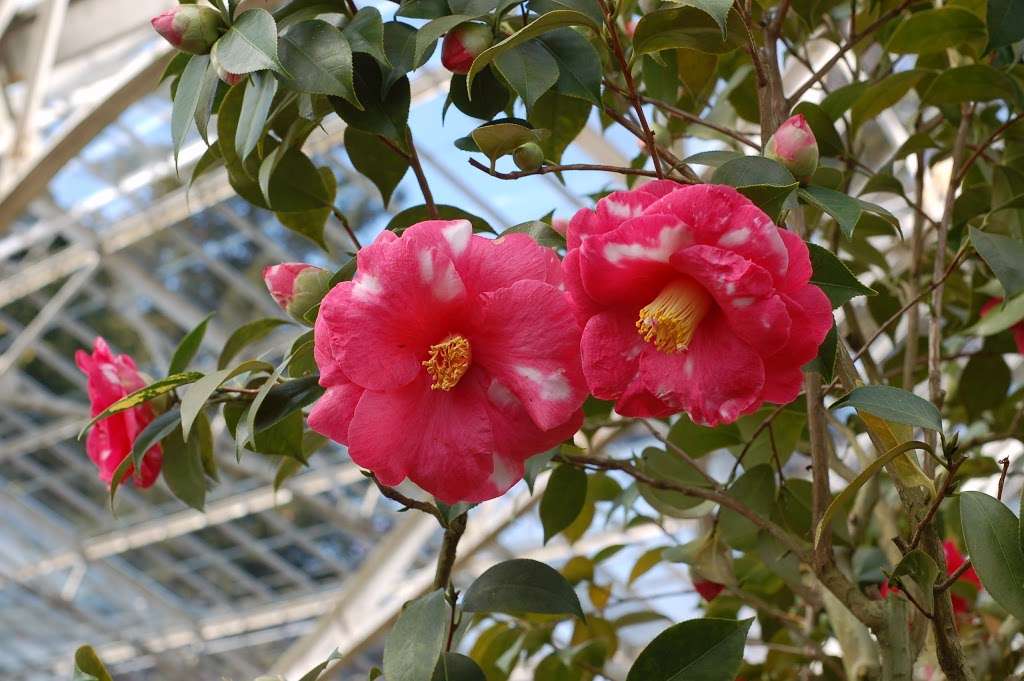The camellia house at Planting Fields Arboretum in Oyster Bay, New York is one of the most iconic and beloved landmarks on the historic Gold Coast estate. This soaring glass greenhouse contains a world-class collection of camellias and provides a magical setting during the annual Camellia Festival each winter.
A Brief History of the Camellia House
The camellia house was originally constructed in 1917 for William and Mai Coe, the former owners of Planting Fields. The Coes had developed a passion for camellias after purchasing their first plants from an English nursery in 1917. To showcase their burgeoning collection, they commissioned prominent New York architect Guy Lowell to design an elegant greenhouse modeled after Joseph Paxton’s famous Chatsworth Great Stove in England.
The original wood and glass camellia house was erected by the esteemed greenhouse builders Lord & Burnham. In 1922 the structure was expanded with the addition of an east and west wing under the guidance of the Olmsted Brothers the influential landscape architects who helped develop the grounds at Planting Fields.
Over the decades, the camellia house has undergone careful restorations to maintain its historic grandeur. The most recent renovations in 2015 repaired the masonry and stucco. Today the camellia house stands as one of the last remaining private greenhouse “conservatories” from the lavish Gold Coast Era of the early 20th century.
The Spectacular Camellia Collection
The camellia house now contains over 200 camellias, with many rare and unusual specimens. The collection includes antique varieties dating back to the early 1900s as well as modern cultivars. The flowers bloom in late winter and early spring, typically from January through March. At peak bloom, the camellia house holds thousands of brilliant blossoms in colors ranging from pristine white to vivid pink. The spacious greenhouse allows the camellias to mature to their full size, with some plants reaching up to 20 feet tall.
Some of the most popular camellias include
-
‘Mikenjaku’ – a crimson bloom with dramatic white speckles and streaks. One of the original camellias from the 1920s.
-
‘Mathotiana Supreme’ – a shell pink flower that fades to apple blossom white at the petal edges. Has a deluxe ruffled form.
-
‘Tom Knudsen’ – a bright red camellia that glows like a beacon in the greenhouse. Medium semi-double flowers.
-
‘Black Magic’ – a deep reddish-brown camellia with a golden boss of stamens. Medium flowers with loose petals.
-
‘Francie L’’ – a very large soft pink bloom edged in white that fades to solid white. A stately flower.
The Camellia Festival
Each winter, the camellia house is the focal point of the much-loved Camellia Festival. This popular two-day event is a sight to behold, with music and activities set amidst thousands of spectacular blooms. Visitors can tour the camellia house, enjoy light snacks, observe art demonstrations, participate in workshops, and take home camellia-themed gifts from vendors. The Camellia Festival typically occurs in late February when most varieties are at their peak.
During the festival, the camellia house truly comes alive as a winter garden wonderland. The sheer volume of color and fragrance transports visitors to another world. It’s easy to imagine you’ve been whisked away to a fragrant floral paradise in the heart of winter. For anyone in the Northeast seeking relief from cabin fever, the Camellia Festival is the perfect cure!
Growing Camellias at Home
Part of the magic of the camellia house is the idea that we could cultivate these aristocratic flowers in our own backyards. With proper care, many camellia varieties can thrive year-round outdoors in climates similar to Long Island. Here are some tips for growing camellias in the landscape:
-
Choose a spot with dappled sun or light afternoon shade. Morning sun is tolerated.
-
Provide rich, acidic, well-draining soil amended with organic matter. Shelter from wind.
-
Water regularly to maintain evenly moist soil. Mulch around plants.
-
Feed in early spring and summer with camellia fertilizer or azalea food.
-
Prune selectively after blooming to shape and remove dead branches. Avoid heavy shearing.
-
Protect from winter wind and cold with breathable burlap screen.
With the right location and care, many exquisite camellias can prosper outside the camellia house in home gardens. For dazzling winter blooms in colder climates, camellias make lovely greenhouse specimens too.
The Timeless Allure of the Camellia House
The camellia house at Planting Fields presents a rare chance to see hundreds of camellias at their peak grandeur in one location. The greenhouse itself is a priceless historic treasure, as lavish as the flowers it shelters. During the Camellia Festival, this floral exhibition springs to life in all its glory. For anyone visiting Long Island in late winter, be sure to attend this spectacular event. Just be prepared for crowds of flower lovers vying for photos – the camellia house is supremely photogenic!

Be the first to know
Topics you care about, straight to your inbox
To The Camellia House, Planting Fields Arboretum – Oyster Bay, New York
0
